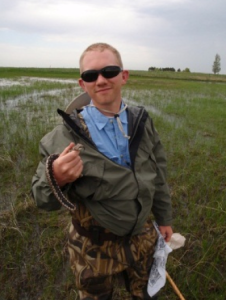Kyle Gustafson
Kyle Gustafson
 Kyle Gustafson
Kyle Gustafson
Position: Lab Affiliate; Post-Doctoral Researcher in our lab 2016-2018; Now Asst Professor, Arkansas State University.
Project: Mountain Lion Population Genomics: Bear Molecular Mark Recapture
Education: B.Sc, Wildlfe Biology, University of North Dakota, 2009; M.Sc, Biology, University of North Dakota, 2011; PhD Zoology, Oklahoma State University, 2016
Email: kgustafson@astate.edu
Website: https://gustafsonlab.github.io/
Research Interests
In general, I am interested in the environmental conditions that influence the abundance and distribution of animal (host) and parasite populations, neither of which are independent from the other. I integrate laboratory experiments, field studies, GIS, and population genomics to better understand population patterns in nature.
Mountain lion landscape genetics and population genomics (University of Wyoming)
View landscape genetics information here >
Host–Parasite Interactions (Oklahoma State University)
Parasitism is a symbiotic cost–benefit relationship between two species where one species (i.e., the parasite) must live within-or-on the other species (i.e., the host) in order complete its life cycle. Parasites, including organism that are parasitic for at least one stage in their life cycle, are estimated to make up half of the species on Earth, and can exhibit greater biomass than vertebrate predators in some ecosystems. As a result, parasitism is thought to affect the life history of nearly every known organism. My Ph.D. explored environmental effects (natural and anthropogenic) on host–parasite interactions. My first aim was to understand how atrazine, a commonly used herbicide, affected hosts, parasites, parasite transmission, and host–parasite interactions (including interactive effects of atrazine and parasitism on hosts, the production of parasites from hosts, and parasite infectivity to hosts). The second part of my dissertation focuses on natural environmental effects on hosts, parasites, and host–parasite interactions, including the effects of habitat on host morphology, parasite distributions, and parasite-induced morphologies.
Amphibians and their Parasites (University of North Dakota)
Amphibians are excellent models for studying parasite transmission because they spend some of their life in aquatic habitats and some of their life in terrestrial habitats. Thus, they encounter a variety of different parasitic organisms with diverse life-cycle strategies. They also serve as second intermediate hosts for birds, fish, reptiles, mammals, and even other amphibians. My thesis focused on the temporal and spatial ecology of amphibian populations and their parasites.
Publications:
 https://www.researchgate.net/profile/Kyle_Gustafson2
https://www.researchgate.net/profile/Kyle_Gustafson2
 https://scholar.google.com/citations?user=L_njj64AAAAJ&hl=en
https://scholar.google.com/citations?user=L_njj64AAAAJ&hl=en
[whohit]Kyle Gustafson[/whohit]

